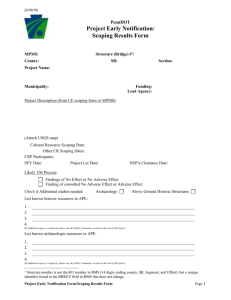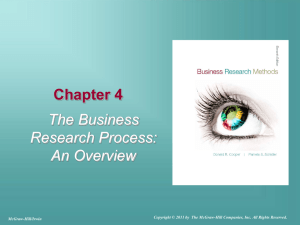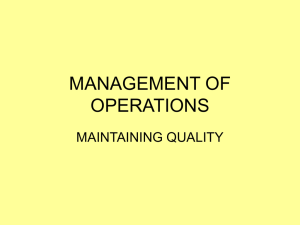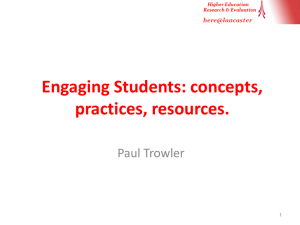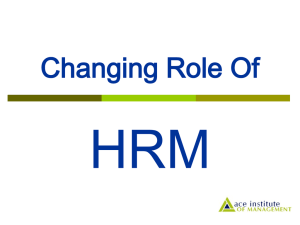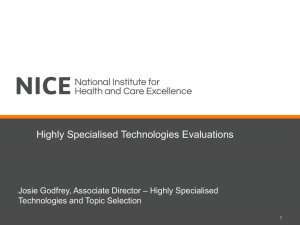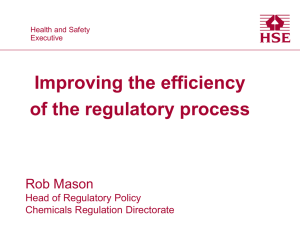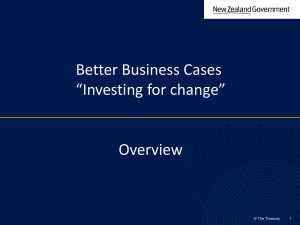Module 2: Land and Conflict Prevention Handbook (Freudenberger)
advertisement
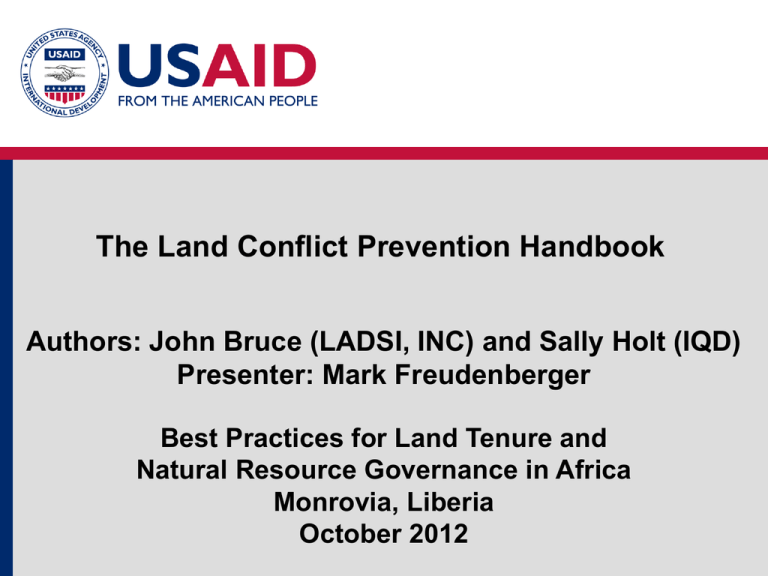
The Land Conflict Prevention Handbook Authors: John Bruce (LADSI, INC) and Sally Holt (IQD) Presenter: Mark Freudenberger Best Practices for Land Tenure and Natural Resource Governance in Africa Monrovia, Liberia October 2012 Presentation – The Key Messages Issue: Competition over resources is to be expected, and even conflict can be creative. But conflict that spins into violence has tragic results and often does little to resolve the issues concerned. Question: What lessons can we draw from the extensive experience with land-related conflict about how to prevent such conflict from turning violent? Presentation: Presents a process for understanding land-related conflict, and options for mitigating conflict and preventing violence. 2 The Conflict Conundrum 3 Source: Center of Spatial Analysis, University College of London (www.theatlanticcities.com/politics/2012/09/depressingly-crowded-map-conflicts-africa/3264/) Step-by-step process of Conflict Mediation STEP 1: Scoping Identifying and understanding potential and existing conflicts and the relevant normative framework within which they occur STEP 2: Assessment Systematic gathering and analysis of data STEP 3: Proposing response options Identifying & proposing concrete options in policy, law and practice STEP 4: Ensuring effective roles Promoting implementation by defining own role and influencing other actors 4 STEP 1: Scoping Scoping (Step 1) STEP 2: Assessment STEP 3: Proposing response options STEP 4: Ensuring effective roles Preliminary characterisation and assessment • Identifying claimants and other stakeholders, and the nature of their claims and interests • Defining interests reflected in and identified by claims • Assessing perceptions of claims, including symbolic and identity issues • Clarifying claims • Assessing on-going disputes • Gauging risks of escalation Information sources include politicians, casual observers, involved stakeholders, and independent experts and commentators 5 STEP 1: Scoping Scoping (Step 1) STEP 2: Assessment STEP 3: Proposing response options STEP 4: Ensuring effective roles Key factors creating vulnerability to land conflict • Land scarcity • Insecurity of land tenure • Normative dissonance • Land grievance Proximate causes & trigger events • Intensifying competition • Displacement events • Political events Source: The Guardian (4 July 2009) 6 STEP 1: Scoping Assessment (Step 2) STEP 2: Assessment STEP 3: Proposing response options STEP 4: Ensuring effective roles Data collection tools •Key informant interviews •Large group meetings •Focus groups •Community assessments •Studies of recent and on-going land disputes •Household case studies Stakeholder analysis tools •Stakeholder group profiles •Stakeholder group interest analysis •Mapping groups and relationships through graphic expressions •Assessing the data through a political economy lens 7 STEP 1: Scoping Assessment (Step 2) STEP 2: Assessment STEP 3: Proposing response options STEP 4: Ensuring effective roles Assessing legal and institutional frameworks • Consult sources of national law on land resources • Ascertain customary rules (to understand claims) • Assess the legal framework: Do conflicts arise — Within an accepted and agreed normative framework? — (Partly) due to disagreements over law and dispute resolution mechanisms? Assessing interaction between customary land tenure and national law Effective practice = adaptation of customary tenure systems and their coordination with statutory law in a harmonised system of land law 8 STEP 1: Scoping Assessment (Step 2) STEP 2: Assessment STEP 3: Proposing response options STEP 4: Ensuring effective roles Considerations in assessing land sector institutions • The extent (and legitimacy) of the powers of the executive • Capacity of and coordination between relevant ministries • Capacity and functioning of land commissions where they exist • The relationship between national legal and customary institutions 9 STEP 1: Scoping Assessment (Step 2) STEP 2: Assessment STEP 3: Proposing response options STEP 4: Ensuring effective roles Relevant factors in assessing prospects for change • Political stability • Awareness and engagement • Class and identity politics • Corruption and vested interests • Political will • Capacity 10 Responding to Threats of Violent Conflict STEP 1: Scoping STEP 2: Assessment STEP 3: Proposing response options STEP 4: Ensuring effective roles Process measures • Enhance the function of land tenure systems • Reduce tensions and buy time Substantive measures • Address underlying issues such as land access, land rights, and land distribution • Directly reduce vulnerability to conflict 11 STEP 1: Scoping Process measures STEP 2: Assessment STEP 3: Proposing response options STEP 4: Ensuring effective roles I. Improving land administration •Enhancing institutional capacity (training, equipment, simplifying procedures, transparency, reorganisation, etc.) •Eliminating practices that discriminate between different groups in competition for land and ensuring effective complaints mechanisms including an ombudsman •Ensuring adequate salaries and realistic fees for services •Decentralisation to bring land administration facilities and services closer to local communities •Devolution of decision-making over land to local levels (principle of subsidiarity) 12 STEP 1: Scoping Process measures STEP 2: Assessment STEP 3: Proposing response options STEP 4: Ensuring effective roles II. Improving land dispute resolution • Improving the substantive rules that govern the resolution of land disputes. Example: adverse possession, abandonment • Providing efficient mechanisms for dispute resolution, through improving formal dispute resolution, incorporating alternative dispute resolution and recognizing customary dispute resolution • Seeking viable compromises (as opposed to winner-takes-all solutions) through mechanisms such as compensation and landsharing Where the parties to conflict do not agree on the applicable law, compromise of perceived legal rights becomes essential in reaching a resolution acceptable to all parties 13 STEP 1: Scoping Process measures STEP 2: Assessment STEP 3: Proposing response options STEP 4: Ensuring effective roles III. Empowering communities to pursue land rights • Public education on land law and administrative procedures • Training of community level paralegals to act as a bridge to the formal system • Ensuring access to fora for communities to voice concerns (projects and political processes) • Support for community leadership that is legitimate and responsible 14 STEP 1: Scoping Substantive measures STEP 2: Assessment STEP 3: Proposing response options STEP 4: Ensuring effective roles l. Strengthening Existing Rights • Strengthening of rights of land users in land resources where tenure is weak or short-term and provides little protection. • Legal recognition of previously unrecognised land claims -- particularly under customary law • Documenting and recording land rights through titling and official recording or registration. 15 STEP 1: Scoping Substantive measures STEP 2: Assessment STEP 3: Proposing response options STEP 4: Ensuring effective roles II. Limiting dispossession: restraining state action • Reforming state land allocations, which often involve ‘cheap land’ policies encouraging speculation and rent-seeking. Reforms to decrease opportunities for rent-seeking. Public land distribution should be at market price except where a specific non-economic purpose is being pursued (e.g., resettlement of displaced persons) • Minimising/mitigating exclusion in concessions, reserves, etc. using rigorous proposal screening and strong community consultation to minimise displacement. • Restraining formal ‘takings’ for public uses and projects in the public interest, by narrowly defining “public interest” and enforcing fair compensation standards • Strengthening public land management to ensure public land is seen as a limited and valuable State asset, with a public lands law, clearly stating rights and responsibilities of all partners 16 STEP 1: Scoping Substantive measures STEP 2: Assessment STEP 3: Proposing response options STEP 4: Ensuring effective roles III. Improving access • Settlement and Resettlement Programs - Risks where land already occupied/used. Will require service provision, livelihoods/other support. Potential environmental impacts • Land reform through expropriation - 3 main models: a) Land to the tiller reform e.g. post WW II reforms in Asia, b) breakup of large integrated farms e.g. Latin America Latifundia, and c) breakup of state or collective farms e.g. Central Asia • Market mechanism land reform makes credit available to groups and subsidises and facilitates their purchase of land • Restitution reforms return land to original landholders where has been taken through processes viewed as illegitimate • Creating and Reforming rental markets, e.g, permitting rentals of land and housing, regulating tenancy to reduced imbalance of power in tenancy relationships, and making more affordable rental housing or land available 17 (private & public) STEP 1: Scoping Choosing among conflict resolution measures STEP 2: Assessment STEP 3: Proposing response options STEP 4: Ensuring effective roles Questions for consideration • What are the options being considered in current dialogues? In case of political impasse what are the entrenched positions? To what extent would those options under consideration address your needs/interests and demands? • What other options are conceivable? How far would they meet the needs, interests and demands of other stakeholders? • Could some solutions plant the seeds for new grievances? If so, how can this be avoided? • How to promote preferred options or introduce new options into national policy discourse? 18 STEP 1: Scoping Promoting responses & influencing change STEP 2: Assessment STEP 3: Proposing response options STEP 4: Ensuring effective roles Potential entry points and nature of engagement depend upon: •Stage of conflict (pre, during or post), as a determinant of what can realistically be undertaken •Capacity of national land institutions (public, private, civil) •Mandates, missions and approaches of relevant actors •Existing and potential ability to influence policy in the land sector and fund and implement relevant projects 19 STEP 1: Scoping Promoting responses & influencing change STEP 2: Assessment STEP 3: Proposing response options STEP 4: Ensuring effective roles Strategic considerations 1.Within nested conflicts, are there mechanisms, processes and capacities in place that can be harnessed to achieve identified objectives? The Arena of Nested Conflicts 2.How can local and regional buy-in be secured in support of solutions? Who are your constituents/supporters and how can this constituency be further mobilised (e.g. legal empowerment processes). Is there potential for alliances with other interest groups? 20 STEP 1: Scoping Promoting responses & influencing change STEP 2: Assessment STEP 3: Proposing response options STEP 4: Ensuring effective roles Strategic considerations The Arena of Nested Conflicts 3. Does one have international support and how could this be further developed? How can such support and pressure be best applied (e.g. economic assistance, international diplomacy)? 4. Are there any windows of opportunity/risks (e.g. changes in political landscape)? 21
